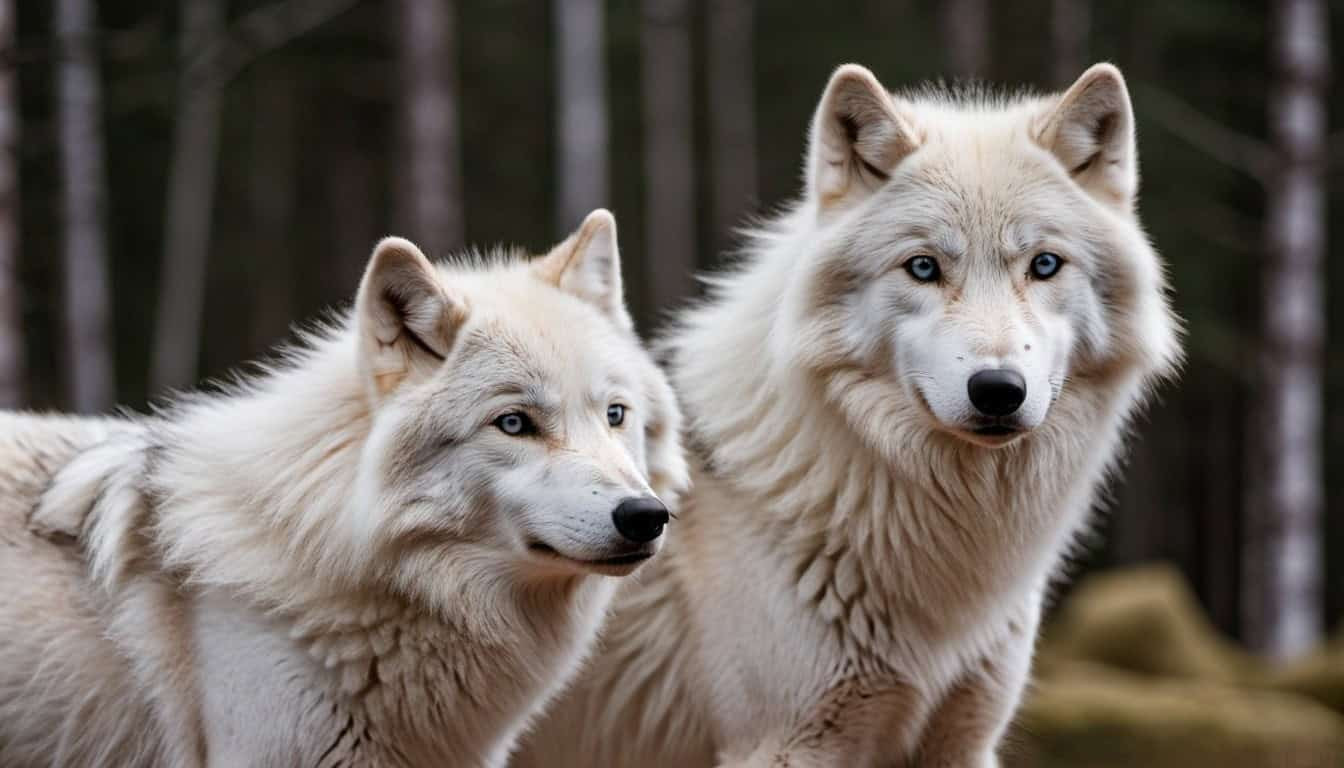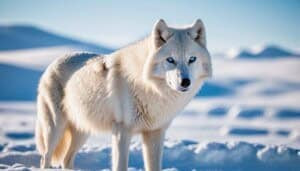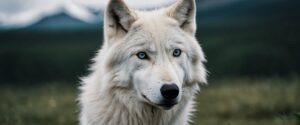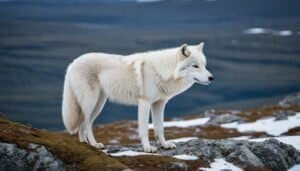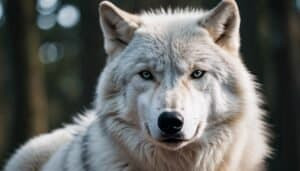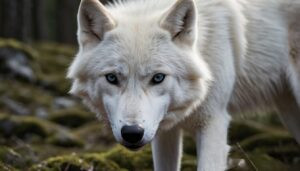Introduction
Pheromones play a crucial role in the complex social and behavioral patterns of Arctic wolves. These chemical signals are integral to communication within the pack, influencing everything from hierarchy and mating to hunting and territorial behaviors
Throughout this article, we will explore how pheromones shape the interactions and survival strategies of Arctic wolves, delving into specific aspects such as pack dynamics, reproductive communication, and environmental impacts on pheromone production
Understanding these mechanisms provides valuable insight into the intricate lives of these fascinating creatures
Communication in Arctic Wolves
Effective communication is essential for the survival and social structure of Arctic wolves. Pheromones, as chemical signals, play a significant role in facilitating interactions among pack members, ensuring coordination and cohesion within the group
This section explores the different types of pheromones, their sources, and their impact on the pack hierarchy and recognition of members
Types of Pheromones
Arctic wolves, like many animals, produce several types of pheromones, each serving distinct purposes. These chemical signals can be broadly categorized into alarm pheromones, territory-marking pheromones, reproductive pheromones, and social pheromones:
Alarm Pheromones: These are released in response to threats or danger, alerting other pack members to potential hazards. When a wolf encounters a predator or an unfamiliar wolf, it can release these pheromones to signal the need for caution or defense
Territory-Marking Pheromones: These are crucial for defining and maintaining the boundaries of the pack’s territory. By marking their territory with urine or glandular secretions, Arctic wolves communicate their presence and deter intruders, thereby reducing conflicts and maintaining social stability
Reproductive Pheromones: These pheromones are vital for attracting mates and signaling reproductive status. During the breeding season, female wolves release pheromones that indicate their fertility, attracting potential mates and facilitating successful reproduction
Social Pheromones: These facilitate bonding and cooperation within the pack. They help establish and reinforce social bonds, ensuring that pack members work together harmoniously in hunting and rearing young
Scent Glands and Their Functions
Arctic wolves have specialized scent glands located in various parts of their bodies, each producing different pheromones for specific functions:
Anal Glands: These glands produce strong-smelling secretions used primarily for marking territory and identifying individuals. The unique scent from these glands helps wolves distinguish between pack members and strangers
Interdigital Glands: Located between the toes, these glands leave scent trails on the ground as wolves move, aiding in navigation and communication of their presence to other pack members
Precaudal Gland: Situated near the base of the tail, this gland releases scents used in social interactions, such as greeting and reinforcing social bonds within the pack
Sebaceous Glands: Found on the skin, these glands secrete oils that carry pheromones important for social cohesion and recognition among pack members
Role in Pack Hierarchy
Pheromones are pivotal in establishing and maintaining the hierarchy within an Arctic wolf pack. The alpha pair, typically the dominant male and female, use pheromones to assert their dominance and suppress the reproductive capabilities of subordinate wolves
This ensures that only the alpha pair breeds, maintaining genetic control within the pack:
Dominance Signals: The alpha wolves release specific pheromones that signal their dominant status. These chemical cues are recognized by subordinate wolves, reinforcing the social structure and reducing conflicts
Submissive Responses: Subordinate wolves often exhibit behaviors such as lowering their body posture or licking the faces of dominant wolves, which are reinforced by pheromonal cues, ensuring clear communication of social ranks
Conflict Resolution: Pheromones also play a role in resolving disputes within the pack. Chemical signals help de-escalate tensions and promote reconciliation, maintaining harmony and cooperation among pack members
Recognizing Pack Members
One of the essential functions of pheromones is to help Arctic wolves recognize and identify their pack members
This recognition is crucial for maintaining social cohesion and effective collaboration in hunting and rearing young:
Individual Scent Profiles: Each wolf has a unique scent profile composed of various pheromones. These profiles enable wolves to identify each other and ensure that they do not mistake a pack member for an outsider
Pup Identification: Pheromones are particularly important for mothers to recognize their pups and vice versa. This recognition ensures that the mother provides care and protection to her offspring, and the pups can find their mother among other pack members
Social Integration: New members or pups born into the pack learn to recognize the scent profiles of other pack members through frequent social interactions, facilitated by the exchange of pheromones
Reproductive Behavior and Pheromones
Reproductive behavior in Arctic wolves is intricately linked to pheromones, which play a crucial role in mating signals, communication between parents and pups, and overall reproductive success
This section explores how these chemical signals influence reproductive activities and ensure the continuation of the species
Mating Signals
Pheromones are essential in signaling reproductive readiness and attracting mates among Arctic wolves. During the breeding season, which typically occurs once a year in late winter, these chemical cues become particularly significant:
Estrus Pheromones: Female Arctic wolves release specific pheromones when they are in estrus, indicating their fertility and readiness to mate
These pheromones are often found in their urine and other glandular secretions. Males detect these signals and are drawn to the females, initiating courtship and mating behaviors
Attracting Mates: The pheromones released by females not only indicate their reproductive status but also help attract the most genetically suitable males. Males with superior genetic qualities are more sensitive to these pheromones, ensuring that the strongest individuals contribute to the gene pool
Courtship Behavior: The detection of estrus pheromones triggers courtship behaviors in males, such as increased scent marking, howling, and close physical contact with the female. These behaviors help establish a bond between the mating pair and facilitate successful copulation
Parental Communication with Pups
After mating, pheromones continue to play a vital role in the reproductive cycle, particularly in the communication between parents and their offspring
These chemical signals ensure the proper care and development of the pups:
Maternal Pheromones: Female wolves produce pheromones that help their pups recognize and bond with them. These pheromones are crucial during the early stages of life, ensuring that the pups can find their mother for nursing and protection
Pup Recognition: Pups are born with the ability to recognize their mother’s unique scent profile. This recognition is essential for their survival, as it helps them stay close to their mother and avoid getting lost or abandoned
Weaning Process: As the pups grow, the mother’s pheromones play a role in the weaning process. Changes in the pheromonal composition of her milk and other secretions signal to the pups that it is time to transition to solid food, aiding in their development and independence
Father’s Role: Although the alpha male does not produce the same nurturing pheromones as the female, he contributes to the pups’ upbringing by marking the den area with his scent. This marking reassures the pups of a protected territory and helps integrate them into the pack’s social structure
Territorial and Hunting Behaviors
Pheromones are fundamental to the territorial and hunting behaviors of Arctic wolves, helping them define their range, coordinate during hunts, and interact with other species
This section delves into how these chemical signals shape these critical aspects of their survival
Territorial Marking
Territoriality is a key aspect of Arctic wolf behavior, ensuring that each pack has access to sufficient resources and reducing conflicts with other packs. Pheromones play a crucial role in establishing and maintaining these territorial boundaries:
Urine Marking: Arctic wolves use urine to mark the boundaries of their territory
The urine contains pheromones that convey information about the individual wolf’s identity, reproductive status, and hierarchical position within the pack. These marks are strategically placed along the perimeter of their territory to signal ownership to other wolves
Scent Gland Secretions: In addition to urine, wolves use secretions from their anal, precaudal, and interdigital glands to reinforce territorial boundaries
These glands produce strong-smelling pheromones that linger for extended periods, providing long-lasting markers that communicate the presence and dominance of the pack
Scratching and Rolling: Wolves often scratch the ground and roll in scent marks to spread their pheromones further
This behavior enhances the scent markers, making them more detectable to other wolves. Scratching also releases pheromones from the interdigital glands, adding to the complexity of the scent profile
Territorial Patrols: Regular patrols by pack members help maintain and reinforce these scent markers. During these patrols, wolves renew their scent marks and check for any signs of intrusion by other packs or solitary wolves, ensuring that their territory remains clearly defined and defended
Coordination During Hunts
Pheromones are also integral to the hunting strategies of Arctic wolves. These chemical signals facilitate coordination and communication among pack members, enhancing their efficiency and success in capturing prey:
Pre-Hunt Communication: Before embarking on a hunt, wolves engage in a series of behaviors that involve the exchange of pheromones. These behaviors include mutual sniffing, licking, and body rubbing, which help synchronize the pack and prepare them for cooperative hunting
Scent Trails: During the hunt, wolves leave scent trails that help them track their movements and communicate with other pack members. The interdigital glands play a crucial role here, as the pheromones released with each step create a trail that others can follow
Post-Hunt Signaling: After a successful hunt, wolves use pheromones to signal the location of the kill to other pack members. This is particularly important when the pack is dispersed over a large area. By leaving scent markers around the kill site, wolves ensure that all members can locate and share in the food
Cooperative Behavior: The exchange of pheromones during a hunt reinforces social bonds and cooperation among pack members. This chemical communication ensures that each wolf understands its role in the hunt, whether it is chasing, ambushing, or guarding the prey, leading to a coordinated and effective hunting effort
Responses to Pheromones from Other Species
Arctic wolves do not operate in isolation; they share their habitat with various other species. Their responses to pheromones from these species can affect their behavior and interactions:
Prey Pheromones: Wolves can detect pheromones released by their prey, such as caribou or hares
These chemical cues provide information about the prey’s presence, health, and stress levels, helping wolves decide when and how to hunt. For instance, stressed prey animals release specific pheromones that can alert wolves to their vulnerability
Competitor Pheromones: Wolves are sensitive to the pheromones of other predators, such as bears and foxes, which share their territory. Detecting these pheromones helps wolves avoid direct confrontations and gauge the presence of potential competition for resources
Danger Signals: Pheromones from dangerous animals or those indicating a threat (such as the scent of humans or other large predators) can trigger defensive or evasive behaviors in wolves. This chemical detection system helps them navigate their environment more safely and avoid unnecessary risks
Inter-species Communication: While most pheromonal communication is within species, there are instances where wolves might use pheromones to interact with other species
For example, wolves might mark their territory in areas frequented by prey animals, using these pheromones to influence prey movement and behavior indirectly
Social Dynamics and Environmental Influences
Arctic wolves rely on pheromones not only for direct communication but also to navigate the complexities of their social structures and adapt to their environment
This section explores how pheromones facilitate social bonding and cohesion within the pack and how environmental factors influence pheromone production and use
Social Bonding and Cohesion
Pheromones are essential for maintaining the social fabric of an Arctic wolf pack. These chemical signals help reinforce relationships, establish roles, and ensure the smooth functioning of the group:
Bonding Through Scent: Social interactions among pack members often involve the exchange of pheromones
Activities such as nuzzling, licking, and rubbing against each other allow wolves to share their scents, strengthening social bonds and reaffirming pack unity. This bonding is crucial for cooperation in activities like hunting and raising pups
Alpha Pheromones: The alpha pair uses specific pheromones to assert their dominance and maintain order within the pack
These pheromones signal their leadership status to other pack members, helping to suppress challenges and stabilize the social hierarchy. Subordinate wolves recognize these chemical cues and exhibit behaviors that reinforce the alpha’s authority
Conflict Resolution: Pheromones play a role in mitigating conflicts within the pack. When disputes arise, chemical signals help de-escalate tensions and promote reconciliation
For example, submissive pheromones released by a lower-ranking wolf can signal appeasement to a dominant wolf, reducing the likelihood of aggressive encounters
Cohesion During Hunts: Successful hunting requires precise coordination and teamwork
Pheromones exchanged during pre-hunt rituals help align the pack’s efforts, ensuring that each member knows its role and contributes effectively to the hunt. This chemical communication fosters trust and cooperation, which are vital for capturing prey and sharing resources
Impact of Climate and Habitat
The Arctic environment presents unique challenges that influence the production and use of pheromones by wolves
Factors such as temperature, humidity, and terrain can affect how these chemical signals are produced, detected, and dispersed:
Temperature Variations: Extreme cold temperatures can impact the volatility of pheromones, making them less detectable over long distances
Arctic wolves may compensate by increasing the frequency of scent marking or choosing locations that enhance the longevity of their scent marks, such as sheltered areas or surfaces that retain scent longer
Humidity and Wind: Low humidity levels can cause pheromones to evaporate more quickly, reducing their effectiveness
Conversely, higher humidity can enhance the persistence of scent marks. Wind patterns also play a role in dispersing pheromones, affecting how far and in which direction these chemical signals travel. Wolves may adjust their scent-marking behavior based on prevailing wind conditions to ensure their messages reach intended recipients
Terrain Features: The Arctic landscape, with its open tundra, rocky outcrops, and snow-covered expanses, can influence the placement and effectiveness of scent marks
Wolves often choose prominent features such as rocks, trees, or elevated areas to maximize the visibility and range of their pheromones. These strategic locations help ensure that territorial and communicative signals are widely broadcasted
Seasonal Changes: Seasonal variations in the Arctic can affect pheromone production and behavior. For example, during the breeding season, pheromone activity peaks as wolves seek mates and establish territories
In contrast, during the harsh winter months, the focus shifts to maintaining pack cohesion and optimizing resource use, with pheromones playing a role in these adaptive strategies
Variation in Pheromone Production
The production of pheromones can vary among individual wolves based on factors such as age, sex, health, and social status
These variations contribute to the complexity of chemical communication within the pack:
Age and Development: Pheromone production changes as wolves age. Pups produce different pheromones compared to adults, aiding in their recognition and care by parents. As they mature, their pheromonal profiles evolve, reflecting their growing roles within the pack
Sexual Dimorphism: Male and female wolves produce distinct pheromones, particularly related to reproductive activities
Females release pheromones that signal their estrus status, while males produce scents that convey their readiness to mate and their dominance. These differences ensure effective mating communication and competition
Health and Stress: A wolf’s health and stress levels can influence pheromone production
Healthy wolves produce stronger and more consistent pheromones, which are vital for effective communication. Stress or illness can alter these chemical signals, potentially affecting social interactions and the wolf’s position within the pack
Social Status: Dominant wolves, especially the alpha pair, often have more pronounced pheromonal profiles that reinforce their leadership roles. Subordinate wolves may produce different pheromones that signal their lower status and reduce the likelihood of conflict with dominant pack members
Conclusion
Pheromones play an essential and multifaceted role in the behavior of Arctic wolves, influencing their communication, social dynamics, reproductive activities, territorial marking, and hunting strategies. These chemical signals are fundamental to the survival and cohesion of wolf packs, helping them navigate the harsh Arctic environment and maintain their complex social structures
In terms of communication, pheromones facilitate various interactions within the pack, from establishing hierarchies and resolving conflicts to recognizing pack members and reinforcing social bonds
The use of different types of pheromones—alarm, territory-marking, reproductive, and social—ensures that Arctic wolves can effectively manage their social and environmental challenges
Reproductive behavior in Arctic wolves is heavily influenced by pheromones, which signal mating readiness, attract suitable partners, and aid in parental care and pup development. The specific pheromones released by females during estrus and by both parents during the nurturing phase ensure the successful continuation of the species
Territorial and hunting behaviors are also deeply connected to pheromonal communication
Wolves use urine and glandular secretions to mark their territories and coordinate hunts, ensuring efficient resource use and minimizing conflicts with other packs and species. Pheromones help wolves track their movements, communicate the location of prey, and maintain pack cohesion during hunts
Environmental factors such as temperature, humidity, and terrain significantly impact pheromone production and efficacy. Arctic wolves have adapted their behaviors to optimize the use of these chemical signals under varying conditions, ensuring their messages are effectively transmitted and received
Finally, the production of pheromones varies based on age, sex, health, and social status, adding complexity to the chemical communication system within the pack. These variations allow wolves to convey detailed and nuanced information, enhancing their ability to interact and adapt to their dynamic social and environmental landscapes
Pheromones are integral to the intricate and adaptive behaviors of Arctic wolves, providing a sophisticated means of communication that supports their survival in one of the most challenging environments on Earth
